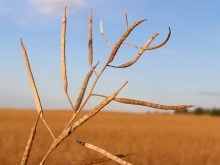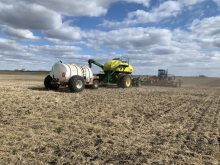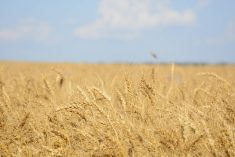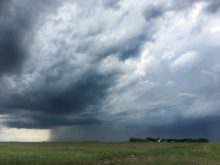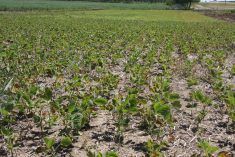The mightiest hailstorm
Bill Greenhough of Genesee, Alta., was only six years old, but he can still remember the hailstorm of 1935 that destroyed grain in the field and ripped the roof to shreds.
“What I remember most was the storm. They pretty well had to feed the cattle the next day,” Greenhough said.
“The storm was so violent that the only thing left from the rubberoid and tarpaper roof was a bit of rubber under big-headed nails. At night the roof leaked and everything was sopping wet and we stood around and shivered.”
Read Also

Government, industry seek canola tariff resolution
Governments and industry continue to discuss how best to deal with Chinese tariffs on Canadian agricultural products, particularly canola.
The next day he climbed a nearby hill to survey the damage and found dozens of partridges, most of them dead but some with their wings broken by the storm.
That fall, the family travelled with their tractor and binder doing custom work to earn money lost from the storm.
Graders in most municipalities go onto the roads at the first snowfall and don’t stop until the roads are clear, but it wasn’t always that way.
Greenhough remembers a wicked storm at the beginning of March in 1953 that was difficult to clear.
“It took me nine hours to go a half mile pushing the snow off the road.”
The next day he and his brother cut a road through the bush where the snow had drifted.
It wasn’t unusual for farmers to become storm stayed.
“That was a bad one. There was still snow in the ditch in June from the drifts.”
A horse hooked up to a sleigh or cutter could usually get people to town by field or road.
“In them days, you were prepared to be housebound for a couple of weeks. You carried more groceries,” Greenhough said.
There never seems to be enough good weather at harvest, but Greenhough said it wasn’t uncommon during the 1960s and 1970s to leave crop in the field for winter. He remembers once combining Dec. 31.
Another year it snowed 10 to 12 centimetres on the standing crop.
“We would go out at night after it froze, maybe 10 p.m. or midnight, and work through the night until morning. As long as it was frozen, it would go through the machine. We piled that grain in a shed. In July (we) sold the last of it and there was still ice in it.”
Every old-timer has stories of walking to school in the winter. Greenhough doesn’t know how accurate the school thermometers were in the one-room schoolhouses he attended as a boy, but one winter the thermometer read -52 F (-46 C) when he and his cousin, Glen, walked the mile and a half to school. The next day was even colder and Bill stayed home. His cousin walked to school, and the teacher was the only one there. It was -54 F (-48 C).
Only the train moved
Bryan Perkins of Wainwright, Alta., remembers Dec. 12, 1955, as the blizzard to end all blizzards when the only thing moving was the passenger train.
The school closed, and country children were sent home by bus. By the time the bus arrived at the Perkins farm, the roads were too bad to continue.
“Half of the kids on the school bus stayed at our place for three or four days and half at the neighbours across the road because they couldn’t get home,” he said.
“I remember we had a great time. I was just a kid then, and we were playing with other kids staying at our place.… Their parents didn’t know where they were. They assumed they were still in town because the phone lines were down. The storm lasted a good day, but there were snow banks that were 12 feet (3 1/2 metres) high. We didn’t have the equipment to clean the snow banks.”
Culture shock
Anita Lischewski of Calahoo, Alta., remembers the shock of leaving Australia during the Christmas of 1981 with temperatures of 40 C and arriving in Canada to find piles of snow and the temperature dropping. She went from wearing shorts to being bundled up in her winter gear.
Her family fed their cattle that winter using a horse and stone boat because there was so much snow.
“If we went off the trail, we got stuck in the snow,” she said. “It was so cold for all of January.”
Get me to the church
Ed Nelson of Stavely, Alta., said he needed help from the rural municipality to get to his sister-in-law’s wedding on March 3, 1955. It sent a snowplow to clear the roads, and Ed and his wife, Otalie, made it to the wedding.
The snow was so deep that Nelson, who is six feet, four inches tall, couldn’t step over the high drifts.
Two weeks later, a chinook blew through southern Alberta and melted all the snow.
“We’re still in a chinook belt,” he said.
Nelson doesn’t recall the year but remembers that one of the neighbours near the Waldron Ranch was snowed in and forced to eat potato peelings until the weather turned and he could travel to get groceries.
Snow days
Ralph Boe of Mannville, Alta., remembers the winter of 1974, when all it seemed to do was snow and blow.
Graders couldn’t keep the roads clear, and Boe and his siblings went to school only three days a week in December, January and February.
“The road would just get clear and it would blow in,” said Boe, who now drives a grader for the County of Minburn.
“Lots of weeks we would leave school at noon on Thursday and not go back until Monday or Tuesday,” he said.
Unlike city kids who could relax and enjoy the time off, Boe said they did chores when they stayed home.
“We always had chores to do, so that is what we did.”
Boe remembers that the drifts were so high he could walk off the roof of the barn onto the snowbank.
“That’s how much it had drifted in.”
One bad blizzard
Abraham Buhler of Hague, Sask., said a blizzard on Jan. 10, 2007, was bad.
“You couldn’t see in front of your vehicle and it lasted most of the daylight hours,” he said.
He also recalled a blizzard in the winter of 1947-48 that lasted for days.
“It was a real blizzard, not just blowing snow. It was a blizzard you could be lost in.”
Buhler stayed inside for most of the day, but twice a day he was forced to venture outside and feed his broiler chickens. A yard light over his barn door and another over his house door guided him between the two buildings.





